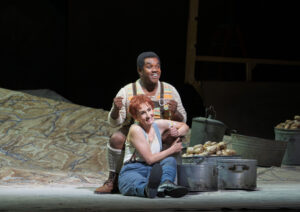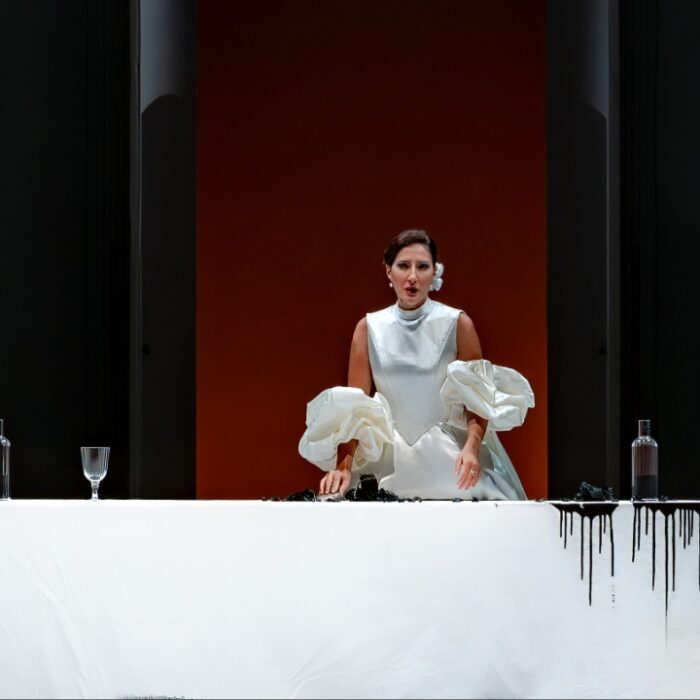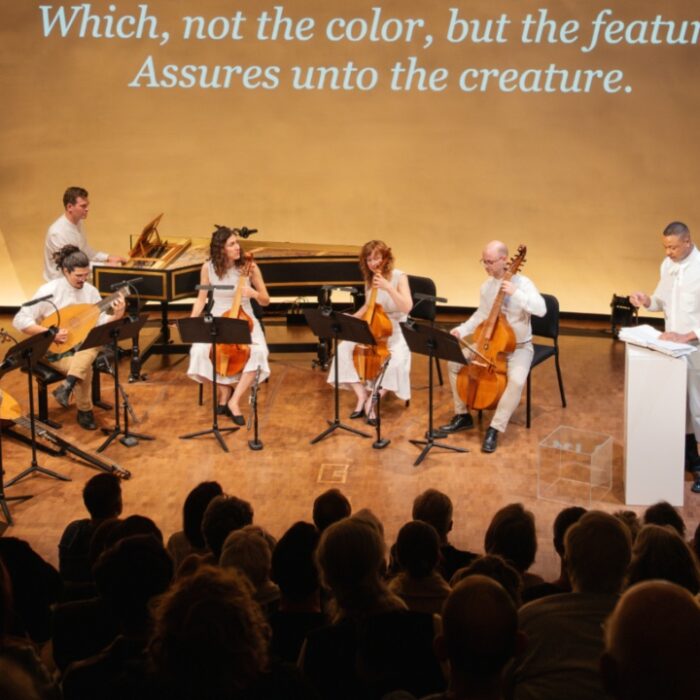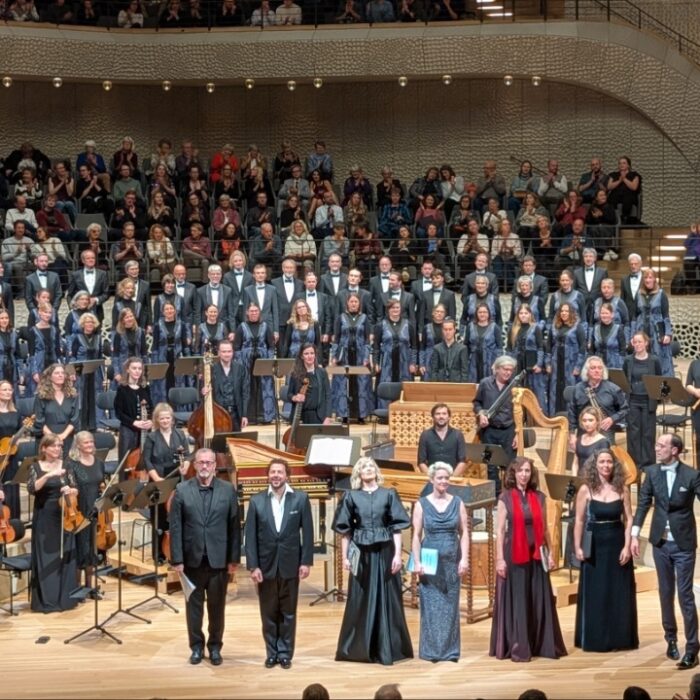
Metropolitan Opera 2025-26 Review: La Fille du Régiment
Encores, Virtuosic High Notes & Great Singing Are Displayed by Erin Morley & Lawrence Brownlee
By Francisco Salazar(Credit: Karen Almond)
Bel Canto is having a bit of a resurgence at the Metropolitan Opera this year, with the company, after years of giving one or no offering per season, currently showcasing two works from the composers of this era.
What is clear from both experiences is that the audience is responding in ways that the Met has not seen in years.
On the evening of Oct. 23, the Met held its second performance of “La Fille du Régiment,” an evening that was filled with laughter, virtuosic roulades and high notes, and yes, an encore that stopped the show for several moments.
A Masterpiece
I will not talk too much about Laurent Pelly’s 2008 production as I reviewed it back in 2018-19, 11 years after premiering at the Met. What I can say from my experience on this evening is that in the right hands and the right performers, this production continues to feel fresh. From the choreography to the backdrop of a French map, it all feels organically placed, allowing the action to flow without any unnecessary interruptions.
What makes this production even more interesting is that it allows its interpreters to play, particularly in Act two with the Duchess of Krakenthorp and the Marquise, who seem to always get a chance to interpolate or improvise something new in each performance. In this case, we got to see Susan Graham and Sandra Oh bring in random English words with Graham partially singing “Yesterday.” That is what truly makes each one of these revivals thoroughly new and special, and what makes this Pelly production timeless.
Vocal Fireworks
In the title role, Erin Morley sang her first Marie ever. The soprano has performed at the Met since 2008 in over 150 performances, but had to this point not been given a platform to show off her Bel Canto skills. This absence was all the more notable, given that the soprano had made an impression in “Chacun le sait, chacun le dit” in the Met’s at Home gala during COVID. The soprano’s performance of this aria was so stunning that it was inevitable that this role would eventually make it to her repertoire. And finally, five years later, she is getting a chance to shine in what, in my opinion, is her best role at the Met to date.
Marie is a role that shows off a soprano’s vocal prowess, singing extreme high notes and singing some complicated coloratura roulades. But she also has some of the most tender moments of the opera. For me, as an audience member, I knew Morley could sing those roulades and display High Gs and E Flats with ease and flexibility. What impressed me most was the emotional “Il faut partir!,” which started with a tender and nostalgic sound and a round legato line. In the repetition, Morley added some gorgeously placed interpolations that always connected beautifully with the musical line. Her sound grew in each repetition of “Il Faut Partir” and her cadenza was dispatched with flexibility and emotion. As the chorus was added to the piece, Morley’s voice rang with even more yearning quality. Her final cadenza as she sang “Mes Amis,” saw the soprano reach stratospheric high notes that resonated with power into the Met.
The subsequent ensemble as she sang “Plus d’avenir ! plus d’espérance!” alongside Lawrence Brownlee gave a certain desperation, and as the final ensemble ended, Morley interpolated an extended High D sideways in the air as she was rushed off the stage.
The other moment that impressed me most was her aria, “Par le rang et par l’opulence,” where Morley once again showed off a fully lyrical sound and some splendid legato phrasing, holding out notes that floated with ethereal sound into the space. She was able to portray Marie’s sentimentality for her home as well as her youthful innocence in the phrase “O vous à qui je fus ravie” before repeating the opening melody in “Je vais signer, hélas ! mon malheur qui s’apprête!.” This time, she delivered the melody with even more longing, especially during her cadenza, holding the final notes and diminuedoing to a piano, the sound dying out as the cello entered for its final bars. “Salut a la France” was a showstopper as she interpolated the “Marseillaise” in a cadenza-like figure before commencing the main melody. Morley inserted some spectacular roulades and brought out that energetic, youthful quality as she moved about the stage, even banging on the piano early on per the directions. Her final High E Flat, once again, was sung as she was suspended in the air by the chorus.
In her more virtuosic music, Morley threw out High Gs and some Fs in her opening duet with Sulpice, all while ironing shirts, running around the hilly stage, and playing with pistols. In the opening of “Chacun le sait, chacun le dit,” her opening cadenza on “Tra la, la, la,” Morley delivered some extremely high notes and robotic movement that called back to her famed interpretation of Olympia in “Les Contes d’Hoffmann.” But then, as she sang the aria, she moved about the stage, high-fiving the troops and later dancing alongside them. Her voice shone with flexibility, and the high notes poured out with seeming ease. She ended the aria with the famed High F she pulled off during the at-home gala. In the Act two trio, “Le jour naissait dans le bocage,” Morley began the ensemble with a nasal and out-of-tune sound before going towards a more forceful and accented phrase that elicited laughter. She also twirled in exaggerated ways before repeating the melody on “Cet amant, à qui Vénus même” where she started to interpolate high notes in more forceful ways, adding to the comic nature of the scene. On the third repeat of the song, Morley’s Marie started banging on the piano and singing the “Tra la la la” with a chesty voice, and later went up to her high range, singing a cadenza that saw her once again imitate a doll-like character. Morley got to play once again with her striking top, reaching the highest extremes of her voice.
This interpretation was exactly what you’d expect from an opera star of the highest order – energized and virtuosic, but exceedingly nuanced and sublime in its execution.
18 High Cs
In the role of Tonio, Lawrence Brownlee had his moment to shine in what was a truly showstopping “A mes amis,” singing high notes to the back of the audience and holding them for some time. His physicality with the chorus showed Tonio’s innocence and happiness, as he continued singing one virtuosic legato line after the next. But what everyone was waiting for were his nine High Cs in “Pour mon âme.” Brownlee had a blast singing each one with effortless clarity and gleaming color. Each time, he held the notes longer until he sang his final one with a smile on his face. The audience went wild, stopping the show dead in its tracks. As Brownlee glanced over at the conductor, the communication could not be clearer. The audience erupted into applause and then died away instantly to give way to the encore, which was just as virtuosic as the first time, with Brownlee relishing every moment, throwing off one High C after another with similar ease and prowess. He sounded as fresh as he had during the first round of “Pour mon âme.” He received another ovation that was even more enthusiastic following the encore. We knew he wouldn’t do it a third time, but the audience certainly sounded like it wanted one.
If Tonio has one of the most delightful and showstopping arias in the opera, he also has one of the most heartfelt moments that sometimes gets overlooked by the virtuosic prowess of his first aria. “Pour me rapprocher de Marie” is one of the most emotionally felt arias that Donizetti ever wrote, and Brownlee sang this with care and exquisite legato phrases. One could really feel Tonio’s plea to the Marquise as he shaped each phrase and grew in intensity. Brownlee’s final High C# was filled with desperation and sentiment. It was another show-stopping moment for the tenor, and the audience responded in kind.
Impeccable Chemistry
While Morley and Brownlee gave incredible individual performances, their chemistry was undeniable. The two, who recently released an album and collaborated on “The Magic Flute” a few seasons ago, displayed this as they ran around the stage each time looking at one another with tenderness and emotion. The smiles in their interaction were infectious and in their duet, “Quoi! Vous m’aimez? … De cet aveu si tendre,” they played beautifully off of one another. Brownlee’s infectious “Depuis l’instant où, dans mes bras,” was sung with clarity and beauty and he smiled throughout. Morley reacted to each of his phrases and at one point lay down out of joy. When they sang the second melody, “De cet aveu si tendre” their voices blended perfectly, singing the roulades with accuracy and always following their phrases to perfection. As Morley sang the first melody, “Longtemps coquette, heureuse et vive,” her voice caressed the phrase with excitement. You could sense this was Marie’s first love. The repetition of “De cet aveu si tendre” once again displayed how well-matched they were, ending in a virtuosic high note.
Comic Timing
Peter Kálmán was a standout as Sulpice, bringing out a booming baritone to the stage. It was the biggest voice of the evening, but he knew how to scale it back as he was performing with his colleagues. His patter was remarkable in the “Au bruit de la guerre” as he and Morley ran around the stage with rifles. In the Act two trio, he was also a great counterpart for Graham as he imitated Morley’s phrases in falsetto, making fun of the song she was singing and then egging her on with the “Rataplan.” In the subsequent trio with Marie and Tonio, “Tous les trois réunis,” Kálmán got to show off his legato line as well as his flexibility in singing patter, all while dancing to the choreographed staging. His interactions with Susan Graham’s Marquise were also full of lightness and flirtation, and with Paul Corona’s Hortensius, Kálmán got to play tough guy, scaring Corona’s character each time.
In the role of the Marquise of Berkenfield, Susan Graham showed off her comic timing with some exquisite French dialogue and some physicality that really brought her character to life. Her interpolation of The Beatles’ “Yesterday” was also a showstopping moment that, while not sung, completely made the audience go wild. Vocally, it’s clear that the mezzo’s voice has gotten a bit smaller, and that was displayed in her short aria “Pour une femme de mon nom.” While she sang with rhythmic accuracy, her voice sometimes got drowned out by the orchestra. That said, she did make the most of the moment, giving the text some comic exaggeration and displaying some fine coloratura as well as accurate patter. In the trio in Act two, Graham’s piano playing was hilarious as she played some of the notes with marked accents and attempted to overemphasize some of the phrasing for Morley’s Marie to follow her.
The Metropolitan Opera has launched a major campaign surrounding the debut of Sandra Oh, who will be playing the Duchess of Krakenthrop. Known for her comic chops and dramatic roles, the Golden Globe-winning actress didn’t disappoint as she walked on stage with an imposing force, delivering her monologue with incredible comic timing and impeccable finesse. She looked at the furniture with disdain and even interacted with conductor Giacomo Saprgipanti when the violins began playing flat. Her facial expressions clearly told everyone she was affected by the terrible playing. Then, in her second entrance with the chorus, she swayed around with exaggerated movements, following every move of the chorus before letting out a shriek when she realized the marriage was no longer happening. That moment made the entire audience giggle as she raced off stage.
Paul Corona’s Horentsius was a great counterpart to Graham’s Marquise, while Yohan Yi’s Corporal showed a strong voice in his small but crucial choral moment.
In the pit, Giacomo Sagripanti led an energetic overture that foreshadowed what the evening would feel like. The Italian conductor displayed great care with each of his singers, always following their tempi and being a great support each time by noticeably applauding their arias. He was even game for the encore of “Pour mon âme,” accompanying Brownlee with the same enthusiasm as the first time. The most outstanding moment of the evening for Sagripanti was Marie’s aria, “Par le rang et par l’opulence,” which saw the conductor and solo cellist follow each of Morley’s phrasings to perfection. It felt like a duet between cello and soprano accompanied by the orchestra. The cellist also had some great moments, especially in the intro, where he really dug into the slides as he opened the nostalgic melody.
In all, this was a triumph and the true return of Bel Canto at the Metropolitan Opera. Hopefully, as the run continues, audiences will get wind and fill up the hall.


